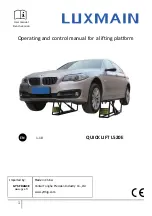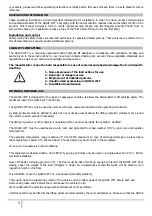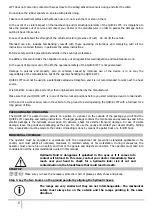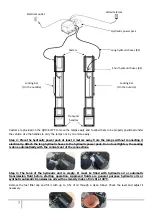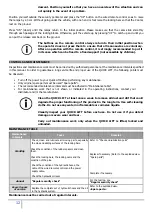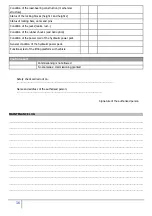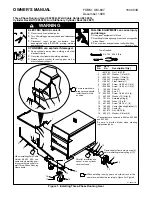
13
Use the "Regular Security Check" form and the Maintenance Log to archive regular and annual checks.
Make a copy of the QUICK LIFT status report and attach it to the operating instructions.
Regular safety checks must be carried out by an authorised person. It is recommended to perform maintenance
simultaneously.
CHECK POINT AND LUBRICATION
All hinge pins are provided with a small hole for lubrication with SAE 90 type
oil (fluid oil). The 6 lubrication points per boom are shown opposite.
Check that the axle nuts are correctly tightened (the nuts are fitted with a
brake to prevent loosening).
TROUBLESHOOTING, CAUSES, SOLUTIONS
Hydraulic Power System Warning: Failure to follow these precautions can result
in serious injury and, in rare cases, death.
All connectors must be properly assembled together before using the Quick Lift
or applying pressure.
Never attempt to connect or disconnect the couplers while the equipment is in
operation or if the hydraulic system is under pressure.
Wear protective equipment (goggles, gloves and safety shoes) when handling the
Quick Lift.
If hydraulic fluid comes into contact with the eyes, enters the bloodstream or is
swallowed, consult a doctor immediately.
Take every precaution to prevent dust or other debris from entering the hydraulic
system.
The table below shows the anomalies that can be observed when using the QUICK LIFT. If the problem is not listed in
the table below, stop using the tool and immediately contact your dealer or the manufacturer for instructions.
TROUBLESHOOTING
CAUSES
Ramps deploy abnormally or do not
descend well.
Check that there are no hydraulic leaks or that one of the hoses is not
pinched or crushed.
Check that the solenoid valve is active (red knob must be in the down
position).
Check that there is sufficient hydraulic fluid in the tank.
Check that the generating set is working (motor noise).
Bleed the cylinders one by one.
The ramps are in the maximum position
(unladen, without vehicle) and do not
descend.
Contact your dealer or the manufacturer. You need assistance.
The ramps do not deploy from their low
position.
Check that the weight of the vehicle is not > 2500kg.
Check that your vehicle has its wheels
There must be a minimum space of 2 to 3 cm between the vehicle's
gripping points and the rubber chocks. For a 2500kg vehicle it will
take several centimetres (about ten).
The ramps go down slowly without using
the wired remote control.
Check that the booms are in the locked position. Never leave the ramps
loaded without first locking the safety bars.
Check that the mechanical control (red knob) of the solenoid valve is
activated. It must be in the down position. If it is in high position it

